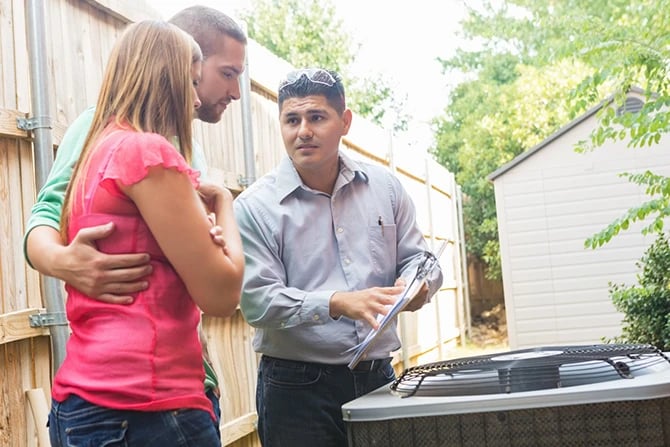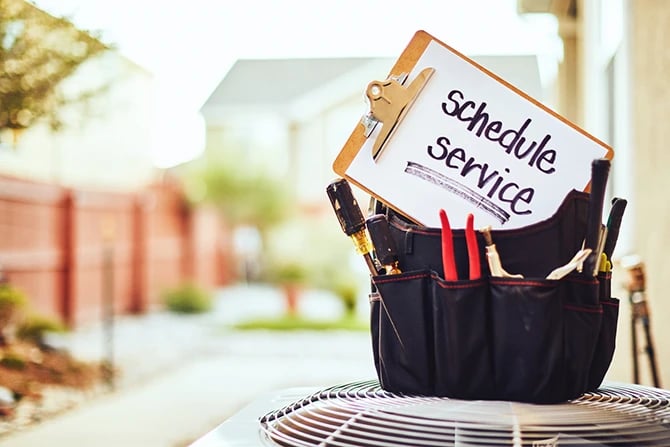We Are Here to Help!
What to Expect from Us:
No Pressure, Just Service!
Get no obligation pricing details and strategies that will work for your business.
Creating engaging content is the secret ingredient that can turn casual viewers into loyal customers of your HVAC business. Read on to find out how you can create social media content that resonates with your audience and showcases your HVAC expertise.
Knowing your audience is the first step. Understand their needs, concerns, and questions. Are they homeowners looking for energy-efficient solutions? Or business owners in need of large-scale HVAC systems? Tailor your HVAC marketing to address their specific requirements and challenges.
HVAC Social Media Marketing
Visual content grabs attention. Visuals make complex information easy to understand and retain. By using high-quality photos, engaging videos, and informative graphics, you will enhance your social media post and attract followers to your social media account.
Videos showing your team at work provide a glimpse behind the scenes, making your brand more relatable. Remember, the key is to connect with your audience genuinely, addressing their needs and concerns while showcasing the expertise of your HVAC company. Here are some content ideas that you can start with:
Posts Showcasing HVAC Service Expertise and Knowledge
Your expertise is your biggest asset. In your HVAC social media advertising or content marketing, share your knowledge about HVAC systems, energy efficiency, maintenance tips, and more. Position yourself as an authority in the field. Write simple yet informative posts about common HVAC issues and solutions. When your audience sees you as a reliable source of information, they are more likely to trust your services.

Posts About HVAC Industry News and Updates
Stay updated with the latest trends and news in the HVAC industry and contractor marketing. Share relevant articles, studies, or advancements. This not only positions your business as current and forward-thinking but also educates your audience about the industry’s progress.
Posts Highlighting Successful Projects and Customer Testimonials
Showcasing your completed projects and customer testimonials adds a personal touch to your social media presence. Share before-and-after pictures of HVAC installations or repairs. Feature testimonials from satisfied customers, emphasizing how your services improved their comfort. Real-life stories build trust and credibility with a new customer looking to try your HVAC service.
Posts On Mastering HVAC Wellness
Educational content is highly valuable. Regularly post tips and tricks related to HVAC maintenance, seasonal check-ups, and energy-saving practices. Create simple tutorials in the form of videos or step-by-step guides. Here are some ways to communicate HVAC wellness on your social media account:
Example #1: The Importance of Regular HVAC Check-ups
Discuss the benefits of scheduling routine HVAC inspections and how it can prevent major breakdowns and save on long-term repair costs.
- Regular HVAC check-ups are essential for your home's comfort and your wallet. Scheduling routine inspections not only ensures your system works efficiently but also prevents major breakdowns. By catching problems early, you can avoid costly repairs in the long run. Think of it like taking your car for regular maintenance to prevent big issues down the road.
Example #2: Energy-Saving Hacks for HVAC Systems
Share practical tips on how homeowners can optimize their HVAC systems to reduce energy consumption and lower utility bills.
- Want to save money on your energy bills? Here are some easy tricks to optimize your HVAC system. First, make sure your home is well-insulated to keep the cool or warm air in, depending on the season. Next, regularly clean or replace your air filters; clogged filters make your system work harder. Use a programmable thermostat to adjust the temperature when you're not home. Lastly, consider ceiling fans – they help circulate air, allowing you to feel comfortable at higher thermostat settings. These small changes can significantly reduce your energy consumption and lower your utility bills!
Example #3: Preparing An HVAC System for Seasonal Changes
Provide a seasonal HVAC maintenance checklist, detailing the tasks homeowners should perform to prepare their systems for winter or summer.
- Getting your HVAC system ready for winter or summer is crucial for a cozy home and lower energy bills. Here's your seasonal maintenance checklist:
Winter:
- Inspect and Replace Filters: Clean or replace filters to ensure efficient airflow.
- Check Thermostat Settings: Adjust settings for winter comfort and energy savings.
- Inspect Insulation: Ensure proper insulation to keep the warm air in and the cold air out.
- Check Ductwork: Seal any leaks in ducts to improve heating efficiency.
- Clean Vents and Registers: Remove dust and debris to maintain proper airflow.
- Schedule Professional Inspection: Have a technician check your system for any issues.
Summer:
- Clean or Replace Filters: Proper airflow is key to efficient cooling.
- Inspect Outdoor Unit: Clear debris and trim vegetation around the unit for good airflow.
- Check Thermostat Settings: Adjust settings for summer comfort and energy savings.
- Clean Evaporator and Condenser Coils: Dirty coils reduce the system's efficiency.
- Ensure Proper Drainage: Clean the condensate drain to prevent clogs.
- Schedule Professional Inspection: Have a technician assess your system before the heat sets in.
Example #4: HVAC System Troubleshooting: When to Call a Professional
Guide homeowners on identifying HVAC issues that require professional intervention, emphasizing the importance of timely repairs to prevent further damage.
- Knowing when to call a professional can save you from bigger problems. Remember, timely professional intervention prevents small issues from turning into costly disasters. If you notice these signs, it's time to pick up the phone:
- Uneven Heating or Cooling: Some rooms are too hot or too cold.
- Strange Noises: Clanking, hissing, or banging sounds are not normal.
- Frequent Cycling: Your system turns on and off too often.
- Increased Energy Bills: Sudden spikes in energy usage indicate a problem.
- Weak Airflow: Poor airflow could signal duct issues or a failing compressor.
- Leaks or Moisture: Water around the unit indicates a problem with the condensate system.
Strong Social Media Presence: Your Key to Online HVAC Service Success
A social media presence is essential for an HVAC company to connect with its audience and thrive online. Here's how to establish a strong social media presence for your brand.

Choose the Right Social Media Platforms
The first step in building your social media presence is selecting the right platforms. Consider where your target audience spends most of their time online. Each social media platform caters to different demographics and interests. If your goal is to improve brand awareness, the popular platforms are Facebook, Instagram, and TikTok. For targeting corporate or small business clients, X (formerly Twitter) or LinkedIn might be better choices.
Set-Up Well-Branded Social Media Profiles
Once you've chosen your platforms, it's crucial to create well-branded profiles for each social media account. Use a consistent profile picture, preferably your logo, across all platforms. Ensure your cover photos and bios reflect your brand identity and values. A cohesive look and feel make your brand easily recognizable.
Optimize Profiles with Relevant Information
Fill out all the necessary information on your profiles. Include your business address, phone number, website, and a brief description of your products or services. Providing accurate details helps potential customers learn more about your business and builds trust.
Post Content Consistently
Consistency is the key to social media success. Develop a posting schedule and stick to it. Whether it's daily, a few times a week, or weekly, regular posts keep your audience engaged. Plan your content in advance, including promotions, behind-the-scenes glimpses, and informative posts related to your industry.
Creating and posting engaging content is the secret ingredient that can turn casual followers into loyal customers.
Engage with Followers
Social media is not just about posting content; it's also about engaging with your audience. Respond promptly to comments, messages, and mentions. Encourage discussions and be genuinely interested in what your followers have to say. Engaging with your audience strengthens your brand-customer relationship.
Encourage Customers to Follow and Interact
Actively encourage your existing customers to follow your social media accounts. You can do this through in-store signage, packaging inserts, or email signatures. Host contests, giveaways, or exclusive promotions for your social media followers. Make them feel valued for being a part of your online community.
By following these steps, you can establish a strong social media presence that not only boosts your brand's visibility but also fosters meaningful connections with your audience. Remember, social media is a two-way street – listen to your customers, respond to their needs, and watch your online presence flourish.
Social Media Integration
A successful marketing strategy involves a seamless integration of various channels to maximize reach and engagement. Social media plays a pivotal role in this integration, complementing Google PPC, website management, direct mail campaigns, and local SEO efforts. Here's how each component can work together cohesively:
Social Media and Google PPC:
- Targeted Google Ads: Align the content of your social media post or Facebook Ads with your Google PPC ad campaigns. Consistent messaging across Google My Business and social media platforms enhances brand recognition.
- Retargeting Strategies: Keep your brand at the forefront of potential customers' minds by using social media platforms for retargeting those who interact with your social media ads or Google ads without converting.

Social Media and Website:
- Content Sharing: Share website content on social media platforms to drive traffic and encourage engagement with social media users who might become a potential customer.
- Social Proof Integration: Showcase customer testimonials and positive reviews from your website or Google review on your social media profiles.
Social Media and Direct Mail Campaigns:
- Promotional Consistency: Ensure that the promotions or offers highlighted in your direct mail campaigns are mirrored on your social media advertising.
- Call-to-Action (CTA): Include icons for your social media platform in your direct mail materials, directing recipients to follow your pages for exclusive deals, tips, and updates.
Social Media and Local SEO:
- Localized Content: Share content on social media that is specific to your local area. This can include posts about local events, community engagement, and projects your HVAC business is involved in.
- NAP Consistency: Ensure that your business name, address, and phone number (NAP) are consistent across your social media profiles and local services ads. Consistent NAP information is crucial for search engine visibility.
Your social media platform provides an avenue for direct engagement with a potential customer, allowing you to address queries and build relationships.
By integrating social media with other channels, the visibility of your HVAC business across various touchpoints increases. Combining this with consistent messaging creates a unified brand image that reinforces your business values and offerings.
A harmonized integration of digital marketing such as social media management, Google PPC, website management, and local SEO with traditional marketing such as direct mail is key to establishing a robust online presence and connecting with your target audience effectively.

Conclusion
HVAC social media marketing is a transformative tool connecting businesses with their audience, building trust, and fostering growth. We encourage your business to implement consistent branding, post engaging content, and utilize data-driven strategies to align your marketing campaigns with your marketing goals.
A holistic marketing approach and social media strategy with coordinated content and engagement across various platforms will allow your HVAC business to stand out, connect effectively, and thrive in the digital age. Seize the opportunity, and let your HVAC business thrive in the social media spotlight.
Our postcards have helped various businesses get leads, boost awareness, and grow revenue. Let us help you create an HVAC marketing postcard design to achieve your marketing goals!

 Cactus Mail Team: Apr 01, 2024
Cactus Mail Team: Apr 01, 2024




